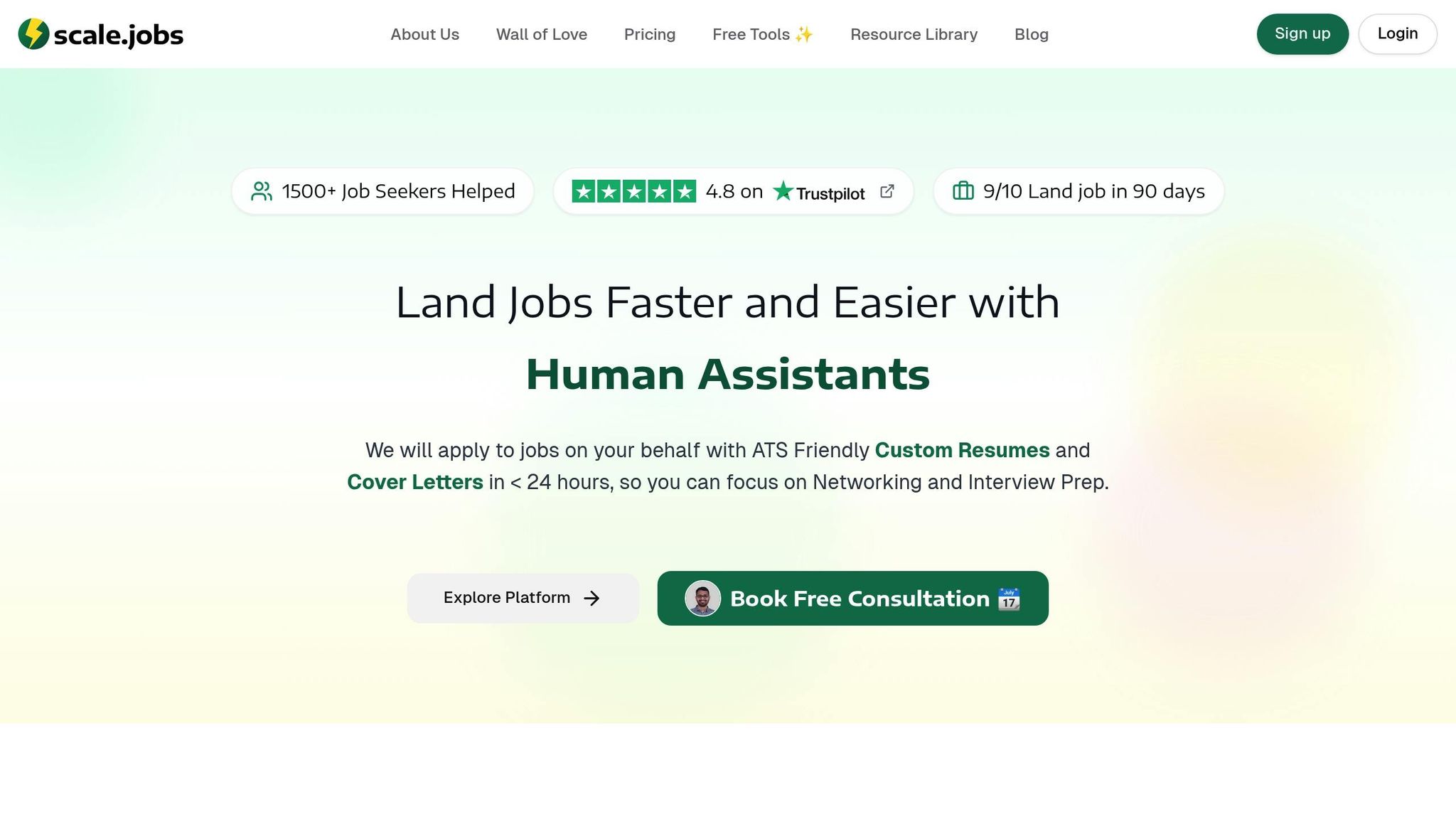5 Problem-Solving Skills Employers Want in 2025
Explore the essential problem-solving skills employers will seek in 2025 and how to effectively showcase them in your job applications.

In 2025, employers are prioritizing problem-solving skills to navigate evolving work environments shaped by automation, remote work, and complex challenges. Here's what they value most:
- Smart Thinking and New Ideas: Break problems into manageable parts and develop original solutions.
- Tackling Hard Problems: Handle complex, high-stakes issues with strategic decision-making.
- Deep Thought and Analysis: Investigate root causes, question assumptions, and provide data-driven solutions.
- Creative Thinking and Initiative: Propose unconventional ideas and take proactive steps to improve outcomes.
- Flexibility and Responsiveness: Adapt quickly to change, manage uncertainty, and turn challenges into opportunities.
Key Takeaways:
- Employers now focus on how candidates solve problems during interviews, not just past achievements.
- To stand out, use the STAR method (Situation, Task, Action, Result) to showcase your problem-solving examples in resumes and interviews.
- Tools like Scale.jobs help tailor applications to highlight these skills effectively.
7 Steps to Improving Your Problem Solving Skills at Work
1. Smart Thinking and New Ideas
Smart thinking means to break hard tasks into small, easy parts. On the other side, new ideas help find new ways to fix these tasks. When you use both, you see problems well and find good fixes.
Bosses want people who do more than just do what they are told. They like workers who can see problems coming, know why they happen, and make fixes that make things better. With companies always facing changes - from new wants from buyers to new tech - these skills matter now more than ever. Let's look at how they work in real jobs.
Putting It to Use at Work
Smart thinking and new ideas show up in many ways at work. For example:
- Data people use these skills to see patterns in how people buy, helping businesses make better products.
- Code writers work through hard code problems to make features that make using the product better.
- Ad people look at how ads do to find good plans and think of new ways to grab people's interest.
Also, project heads use smart thinking to see possible late jobs or money issues soon. They come up with new plans or ways to talk to keep jobs on time. Even in jobs that deal with people, workers look at common problems and feedback to make things better, leading to great results. These cases show how these skills bring worth to all kinds of jobs and roles.
Ways to Get Better at It
If you want to get better at smart thinking, start with asking good questions. Don’t just take easy answers - ask “why” or “what if” to really understand why problems happen.
You can also learn data tools like Excel or Google Sheets. You don't have to know it all, but knowing how to sort data, show it well, and see patterns can make you think clearer.
A good way to practice is by looking at real business problems. Read cases in stuff like Harvard Business Review or Forbes. Think about how you would deal with the problems they talk about and think of new fixes.
Being part of problem-solving groups is also a good plan. Many businesses have teams or groups where workers work together on real projects. Professional groups also have workshops and events where you can try solving problems with your hands.
How to Show Your Problem-Solving Skills When You Apply for Jobs and in Interviews
Once you're good at these skills, show them when you're looking for a job. On your resume, put clear cases of problems you've fixed and what you achieved. For example, instead of writing “made customers happier,” write, “looked at customer feedback to find main issues, then made a new welcome process that raised happiness by 25%.”
Use the STAR method to set up your examples. Talk about the Situation, show the Task you had, tell the Action you took, and explain the Result you got. This way not only shows your problem-solving skills but also gives a clear story for bosses.
When you sit down to talk in job interviews, don't just talk about what got done - show how you think. Bosses want to know how you face tough things, so guide them through how you solve issues with the STAR way. If you can, bring work samples to back your words. It could be a talk, a paper, or proof of you making things better. Showing them can make a strong mark.
For job forms, sites like scale.jobs can help. Their smart tools help shape your resume to shine with these skills for each job. They also have tools to get you ready for talking about your plans well. By using real stories of how you think hard and create new things, you will catch the eye of bosses needing thinkers that solve stuff in the year 2025.
2. Tackling Hard Problems
Tackling hard problems means facing big issues, full of unknowns, and often with a lot on the line. It needs knowing how things link, guessing what might happen, and making choices even if you don't have all the facts.
Using it at Work
This skill is key in many jobs as it fits well with the way work can be up and down. For example:
- Supply chain managers handle moving goods and look for new plans if problems pop up.
- Software engineers team up to fix system bugs fast, lessening downtime and money lost.
- Marketing directors check data, move money around, and work with sales to lift poor campaigns.
- Healthcare admins keep tabs on patient flow, crew times, and money while making sure care stays good.
Ways to Build the Skill
You can grow your skills for hard problems by adding some methods to your daily work:
- Join different team projects: Say yes to jobs that mix parts of the company or need you to weigh different needs.
- Learn systems thinking: Go to meetings, look at reports, and ask questions to understand how your place's parts connect.
- Try scenario planning: Often think up "what if" ideas and weigh up good and bad points of possible fixes.
- Take new tasks: Try work that stretches you, like projects you don’t know, working with overseas teams, or keeping within small budgets.
- Join work groups: Get into trade groups, case contests, or classes that copy real job troubles.
Showing the Skill in Jobs and Talks
Once you're good at this, show it in your job talks and notes. Use clear cases of hard issues you’ve cracked, telling what the problem was, what you did, and what got better. For instance, don’t just say you "made the team better", tell how you "changed how groups work together, making projects quicker and cost less."
Use the STAR method (Situation, Task, Action, Result) to shape your stories. Focus on times you worked with what you had, thought over various needs, or hit close deadlines. In talks, go over how you decided what to do, step by step, showing how you picked out main points, got info, tested options, and shifted with surprises.
If you can, add clear photos in your folder showing how you solve problems and their effects. A clear, shown example can make your point even stronger.
To tune your resume, places like scale.jobs are great. They use AI to help pick what to show for different jobs, and their people make sure your wins are shown right and clear.
Next, we’ll look at how these skills can make you do better in job talks.
3. Deep Thought and Check
Deep thought is about looking at facts with no lean, asking about what we take as true, and going deep to find the real causes of problems. It’s the skill that lets you see what is real from what is not, spot leanings, and fix issues right at their base, not just the signs.
Use in the Work World
Deep thought is key in work places where good choices depend on deep checks. It fits well with solving problems, boosting how you deal with hard spots.
- Money checkers look past simple numbers, checking market moves and risks to pick good spots to put money.
- Item bosses go through user info and work aims to set the order of parts that really make growth, asking if what customers say shows real needs or just hard to use spots.
- HR folks pick people based on what the job needs and how work goes, not just a good-looking resume.
- Ops bosses check ongoing gripes and changes in how things work to find the true reasons for service issues.
Ways to Get Better
Making your deep thought better takes non-stop work and tryouts. Here's how you can do it in your day by day:
- Question what’s given: If someone says, "This is how we’ve always done it", ask why it started and if it’s still the best way.
- Use the “Five Whys” method: Keep asking "why" - five times is good - to dig through a problem and find its base.
- Look for other views: Before you end on a choice, talk to those who may not agree. Read pieces or studies that go against the usual.
- Look at case stories: Think about how choices were made, not just how things ended. What thoughts led the moves? How were they checked?
- Go deep into reports: Don’t just take numbers as they are. Say, if site visits go up 20%, check which pages grew and if those folk turned into buyers.
These ways not only grow your deep thought skills but also give you real cases to show them off.
How to Show the Skill in Jobs and Talks
Once you’ve got your deep thought sharp, it’s time to show it well. Bosses want to see how your checks led to clear wins. Show real times where your views found hidden flaws, looked at them close, and made things better.
Use the STAR method (Situation, Task, Action, Result) to lay out your stories clear. Show how checking the obvious led you to more right ends.
Be ready to share times that show thinking open - times when you changed your view based on new proof or fixed a first wrong step. Bosses like people who can say they messed up and shift as needed.
In talks, ask smart, checking questions. Instead of a usual "What’s the work feel like?" try something more aimed, like, "I saw your new item went to big clients. What info led that big choice?"
If you own a portfolio, break it into parts that show off your skill in analysis. Add in reports, fixed issues, or advice with clear results from before and after, when you can.
At last, think about using tools like scale.jobs to shape and place your samples well for tracking systems. Sharp thought, with other skills to solve problems, boosts your power to manage hard tasks.
4. Creative Thinking and Going First
To go with strong look-at-facts skill, new thought and going first give the kick that makes new ways to fix problems.
New thought and going first is all about making ideas no one else thought about and taking steps on your own. It’s about seeing rare chances and going for them at once. This way of thinking helps you be seen as you’re not just doing what you’re told - you’re looking for ways to be better and make a mark.
Ways it Shows at Work
New thought shows in many ways at work, often leading to big changes. Solving day-to-day troubles with fresh ideas is what makes some top players stand out from others.
- Teams that market look for new ways to pull audiences, like trying not-yet-used social media sites, teaming up in new ways, or finding new spins on old goods.
- Sales people think in new ways to reach hard clients, offering fix plans that meet special needs.
- Code makers face code troubles by mixing tools in new ways or making short cuts that save lots of time.
- Work flow bosses think again about work flows, cut waste, and find smart ways to do more with less.
- Help teams start by spotting usual troubles in complaints and think of fixes before things get worse, often making stop-them-before-they-start processes not just answering.
The magic is in looking past the clear. Where others see blocks, new thinkers see chances to try something new.
Ways to Grow the Skill
Getting better at new thinking needs trying, but small shifts in how you think can mean a lot. The goal is to get your mind to think about new chances.
- Play the "What if" game. Push yourself with what-if questions: What if we turned this around? What if we mixed two ways? What if we cut out this step? This pushes you to think past your normal way.
- Watch other fields. Look at how works in other areas fix troubles. For example, if you sell stuff, see how food places deal with busy times. If you're in tech, see how hospitals handle hard setups. Taking ideas from many fields often leads to the best new thoughts.
- Write down all ideas. Log every thought - no matter if it seems too out-there. Even not-so-good ones can start better answers later.
- Join different team tasks. Working with groups not in your usual area or changing your day-to-day can show you new views and light up new thoughts.
As you get better at these ways, make sure to show your new thinking in your work stuff and talks.
How to Show the Skill in Job Tries and Talks
When you share your new thinking with possible bosses, point to real results. They want to see how your ideas made things better, not just hear about how you think.
- Use the STAR way to show how you solve things in new ways. Tell clear stories of what you did and what you got done. Adding numbers - like how much faster or more you did - makes your stories hit harder.
- Make your resume fit you. Swap out usual words for ones that show what you did better. Like, don't just say, "Handled customer service", say, "Made a fast reply system that cut time needed by 40%." This shows how you lead and the great change you made.
- Get set for talks. Keep a few stories ready that show how you think out of the box. Share times when you made things better, fixed tough issues, spent less, or started new ways. Use stories from jobs, school, or helping out to show your many sides.
- Ask smart questions. In talks, dig deeper than the simple stuff. For instance, don't just ask, "What's the team feel like?" ask, "What hard thing did your team face lately, and how did you solve it?" This shows you really want to know and can think through problems.
- Show how you get there. In a set of work or examples, don't just show the end piece. Talk about why you picked your way and what else you thought of. This lets bosses see how you make cool choices.
Tools like scale.jobs can help shape your papers. Their AI and people might guide you in picking the best stories to fit what bosses look for most.
Creative thinking isn't just about cool art - it’s about finding chances, making moves, and getting better results. When you show this skill well, you stand out as someone who can bring new ideas and true fixes to the group.
5. Being Easy to Change and Good at It
Being able to change and adapt is key when facing the unsure problems that pop up at work. These skills are more than just "going with the flow" - they're about doing well when things change, grabbing chances, and finding new ways to win when things are different.
When you're flexible, you can change how you do things without slowing down. This might be a quick shift in what your project needs to do, new tech coming in, or a surprise change in the market. Being adaptable lets you use these times to grow and get better.
How It Works in the Office
Being easy to change looks different depending on the job, but often it's what makes some teams do well with change while others don't.
- Project managers often see plans, budgets, or goals change. The best ones use these changes to find better ways, move resources around, and keep everyone on the main things.
- Customer service folks meet new or strange problems every day. Adaptable reps think on their feet to fix issues, even without a set guide.
- Software creators need to use new tools, meet new needs, and work with changing teams. Those who accept changes fast pick up new code languages, switch how they work, and keep things moving.
- Marketing pros might have to change course if campaigns don't work or new platforms pop up. They try new ways, tweak their messages, and shift resources to get better results.
- Sales teams change how they talk based on who the client is, what's trending, or updates to the product. Top sellers change their pitch and focus to match what each buyer needs.
Ways to Build This Skill
- Start small with daily habits. Mix things up - take a new way to work, try a new coffee spot, or move things around in your workspace. Small changes like these can make you more okay with change.
- Practice thinking ahead. Guess what tough spots might come up in your projects and think about how you'd deal with them. For example, what would you do if the money was cut by 30% or if a main team player left? Getting ready for these things makes surprises less hard.
- Keep learning. Make time every week to pick up new skills or check out trends outside your main job. Whether it's learning a new software or doing an online class, staying curious keeps you ready for change.
- Go for hard tasks. Say yes to projects that push you or involve new teams. These chances build trust in yourself and teach you how to handle not knowing.
- Work on keeping calm and clear-headed. Things like deep breaths, sitting quietly, and regular workouts can keep you calm and thinking straight when things change.
These habits make you better at adapting and help you show this skill well in your work.
Tips on Showing Your Skill in Job Applications and Interviews
When you've got your skill in changing, it's key to tell this to those who might hire you. They want real examples of when you've dealt with change and got good results.
- Give clear, real examples. Don't just say, "I'm good at changing", tell stories that show you can switch things up. Like, talk about a time when you had to change fast, what you did, and what happened because of it. Using numbers or effects can make what you say hit harder.
- Talk about working in different teams. Show that you've worked well with many groups or in various jobs. This shows you can shift how you talk and act based on what's going on.
- Get ready for tough questions. Prepare to answer things like, "Can you tell us about a time when things had to change fast?" or "How do you deal with surprises?" Use the STAR plan (Situation, Task, Action, Result) to help you answer.
- Prove you learn fast. Speak about times when you quickly learned new skills or ways. Employers like to see that you can keep up without making the team slow.
- Prove you get people. Share times you've helped others in changes or kept spirits up when things were hard. This shows you're not only good at changing yourself but can also help others do it well.
Shape your resume and how you talk in interviews to show these points, using examples that prove you can turn change into your gain.
Being good at changing isn't just about dealing with new things - it's about using them to grow and get better. When you can show this well, you look like someone who makes teams better and does well in busy times.
How to Show Problem-Solving Skills in Job Applications and Interviews
Once you've identified your key problem-solving skills, the next step is showcasing them effectively during your job search. The goal is to provide clear, specific examples on your resume and in interviews that demonstrate your ability to tackle challenges.
Start by using strong, action-oriented language on your resume. Instead of saying, "responsible for customer complaints", try something like, "resolved customer issues efficiently by developing an innovative tracking system." This kind of results-focused phrasing highlights your impact and makes your accomplishments stand out.
To structure your examples, revisit the STAR method (Situation, Task, Action, Result). Tailor your resume and cover letter to address the unique challenges of each role. For example, if you're applying to a startup, emphasize how you thrived under limited resources. On the other hand, if you're targeting a well-established company, focus on how you improved existing processes or navigated complex internal challenges.
Your cover letter is another great place to tell a story. Include a narrative that demonstrates how you solved a significant problem, showcasing your analytical thinking and adaptability.
For interviews, prepare multiple STAR examples that cover a range of challenges you've faced. Walk interviewers through your thought process - how you gathered information, evaluated options, and implemented effective solutions. Employers want to understand not just what you achieved but how you approached the problem.
Additionally, ask thoughtful questions during interviews. For instance, you could ask, "What is the biggest operational challenge your team is currently facing?" This shows you're already thinking about how you can contribute and solve problems.
These strategies will position you as a candidate who brings solutions to the table.
Scale.jobs vs. Find My Profession vs. LazyApply: Which Tool Actually Helps You Stand Out?

When it comes to job search platforms, they each promise to help you highlight your strengths, but they vary in how well they showcase problem-solving skills to potential employers.
Scale.jobs stands out by blending AI technology with human expertise. Their platform creates ATS-compliant resumes that highlight your problem-solving examples in a format optimized for both hiring algorithms and recruiters. With the AI Assistant Pro feature (available at $9/month during launch), you can generate tailored resumes and cover letters for each job application, ensuring your unique skills and experiences shine through.
Here’s how Scale.jobs compares to competitors:
- Find My Profession offers resume writing services but relies heavily on templated processes.
- LazyApply focuses on submitting a high volume of applications, often at the expense of highlighting individual achievements.
| Feature | Scale.jobs | Find My Profession | LazyApply |
|---|---|---|---|
| Custom problem-solving examples | AI-driven personalization with human review | Templated processes | Minimal customization |
| ATS optimization | Advanced built-in ATS compliance | Standard optimization | Limited ATS compatibility |
| Interview preparation | AI-crafted responses to problem-solving queries | Some interview coaching services | Limited support |
| Service Cost | One-time flat fee options | Premium, service-based pricing | Recurring subscription model |
| Human oversight | Trained virtual assistants review every application | Limited human consultation | Fully automated process |
Scale.jobs' Human Assistant service takes things further by manually submitting applications. This ensures your problem-solving skills are effectively showcased across various job portals. They also provide real-time updates via WhatsApp and proof-of-work screenshots, keeping you informed and allowing for strategic adjustments.
For international candidates and visa holders, Scale.jobs offers specialized support. Their human assistants know how to present your qualifications while addressing work authorization concerns, ensuring your value is front and center.
With a flat-fee pricing model, Scale.jobs eliminates the need for recurring subscriptions, and any unused credits are refundable. This makes it a flexible and cost-effective option for job seekers.
Another standout feature is their interview preparation. Scale.jobs provides AI-crafted responses to common problem-solving questions, helping you feel confident and prepared. These tools streamline the job search process while emphasizing the problem-solving skills that set you apart from other candidates.
Conclusion
By 2025, problem-solving skills will be the cornerstone of career success. As automation takes over repetitive tasks, employers are zeroing in on candidates who can think critically, analyze effectively, and bring fresh ideas to the table. The five skills we've discussed - analytical thinking, complex problem-solving, critical thinking, creative thinking, and adaptability - are what set exceptional candidates apart. Developing and showcasing these abilities will be key to standing out in a competitive job market.
To refine these skills, dive into challenging projects and seek out hands-on experiences. Engage with problem-solving groups, take on leadership opportunities, and look for ways to improve processes in your current role. Keep track of your achievements using the STAR method, so you have concrete examples to present to potential employers.
However, even the best skills won’t shine without a targeted job search strategy. Generic resumes and cover letters won’t make the cut in today’s tech-driven hiring process. That’s where Scale.jobs comes in. Combining AI precision with human insights, Scale.jobs ensures your problem-solving expertise is effectively highlighted. Their AI Assistant Pro, available for just $9/month during launch, customizes your application materials, while their Human Assistant service adds a personal touch to make your applications truly stand out.
For those navigating unique challenges - whether you're a recent graduate, a professional dealing with layoffs, a frequent job changer, or an international candidate facing visa hurdles - Scale.jobs provides tailored support. With flat-fee pricing, real-time updates via WhatsApp, and proof-of-work screenshots, they deliver transparency and results that other platforms simply don’t offer.
The 2025 job market belongs to problem-solvers who can clearly demonstrate their value. By sharpening these five essential skills and using the right tools to showcase your expertise, you’ll position yourself as the kind of candidate employers are actively searching for.
FAQs
How can I showcase my problem-solving skills effectively during a job interview using the STAR method?
To effectively demonstrate your problem-solving skills during a job interview, consider using the STAR method: Situation, Task, Action, and Result. Begin by outlining a specific problem you encountered (Situation) and clarify your responsibilities in addressing it (Task). Next, walk the interviewer through the steps you took to tackle the issue (Action), and wrap up by sharing the outcome of your efforts (Result), including any lessons you gained from the experience.
This approach helps you share a well-organized and impactful example of your problem-solving abilities, making it easier for the interviewer to see the value of your actions. Choose examples that align with the job you're applying for and highlight skills like critical thinking, flexibility, and resourcefulness.
How can I develop creative thinking and take initiative in the workplace?
Developing out-of-the-box thinking and taking initiative in a professional environment means actively finding ways to tackle challenges differently and stepping up to take responsibility. One way to start is by brainstorming a variety of solutions to a single problem - even the ones that might seem a bit unconventional at first. Working closely with your colleagues can also help you uncover fresh perspectives and refine ideas together.
When it comes to showing initiative, keep an eye out for inefficiencies or gaps in your current role. Instead of just identifying the issues, come up with practical solutions and share them with your team or manager. Volunteering for projects outside your usual scope is another great way to expand your skills while demonstrating your commitment to growth. Make it a habit to reflect on your work and ask for feedback - it’s a reliable way to spot opportunities for improvement and spark innovation. Employers are always on the lookout for proactive thinkers who can adapt, solve problems, and deliver real results.
Why is adaptability an essential problem-solving skill for the future job market?
Being able to adjust quickly to new circumstances is becoming increasingly important in the job market. As industries transform and automation changes the way we work, having the ability to pick up new skills and adapt to shifts in roles or market demands keeps you relevant and competitive.
Employers prioritize this quality because it shows you're flexible, resilient, and capable of succeeding in fast-changing environments. These abilities are essential for handling challenges like economic fluctuations, technological progress, and shifts within organizations, making you a dependable and prepared professional for the future.




